Sourdough Starter Maintenance
Once you have created an active sourdough starter, looking after your starter is just as important as creating one.
A healthy sourdough starter is a combination of wild natural yeast and bacteria that work together to create sourdough bread’s rise, texture, and taste.
It brings amazing flavor and texture to bread that’s more in-depth than commercial yeast.
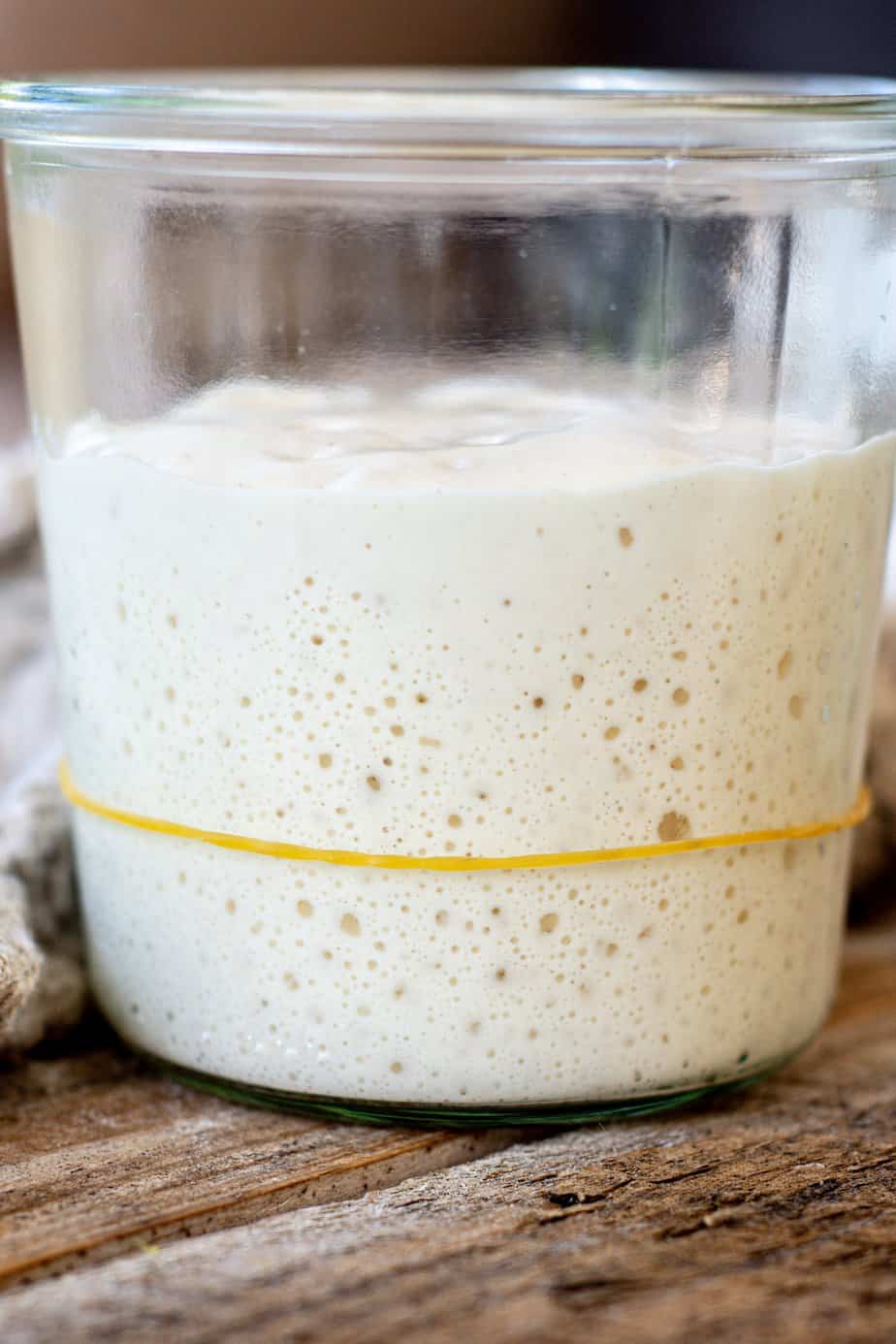
What’s in a starter
Initially, when starting your own sourdough starter, it’s a gradual process of catching and nurturing these wild organisms and giving them food and the ideal environment to grow.
Later on, when you have an active starter that is ready to bake with, the wild natural yeasts will be responsible for the bread’s rise as it releases carbon dioxide. The bacteria in the starter, which is the lactobacillus strain, also release carbon dioxide, but not as much as the yeast. The bacteria is responsible for the sour tang in delicious sourdough bread. This is due to the lactic and acetic acid they produce.
It’s important to keep the sourdough starter refreshed often so there is no buildup of these acids. An overly acidic starter can ruin the gluten structure in sourdough bread, which can make the dough hard to work with.
Feeding sourdough starter
Before continuing with the post, let’s establish the feeding ratios terminology that will be used. Feed your sourdough starter in weight and use a kitchen scale. This keeps things much more consistent than volume measurements.
A basic sourdough feeding is a 1:1:1 ratio, meaning equal parts of seed sourdough starter, flour, and water, measured in weight. For example, 30 grams of starter, 30 grams of flour, and 30 grams of water.
This is also known as a 100% hydration sourdough starter, which is a starter that has equal amounts of flour and water in it, measured in weight. A feeding ratio like this means an active starter should double easily within 4 hours at warm temperatures (between 21°C and 26°C (70°F and 80°F.))
Increasing the fresh flour and water you feed the seed starter (the seed starter is the established starter with which you mix the new flour and water), can slow down the rise of the starter as the organisms have more food to consume.
A ratio of 1:2:2 for example is 1 part seed starter, 2 parts flour, and 2 parts water. Though the mixture of flour and water has increased, this is still a 100% hydration starter. However, the rise will take longer as the seed starter has double the amount of flour to the amount of starter to feed on.
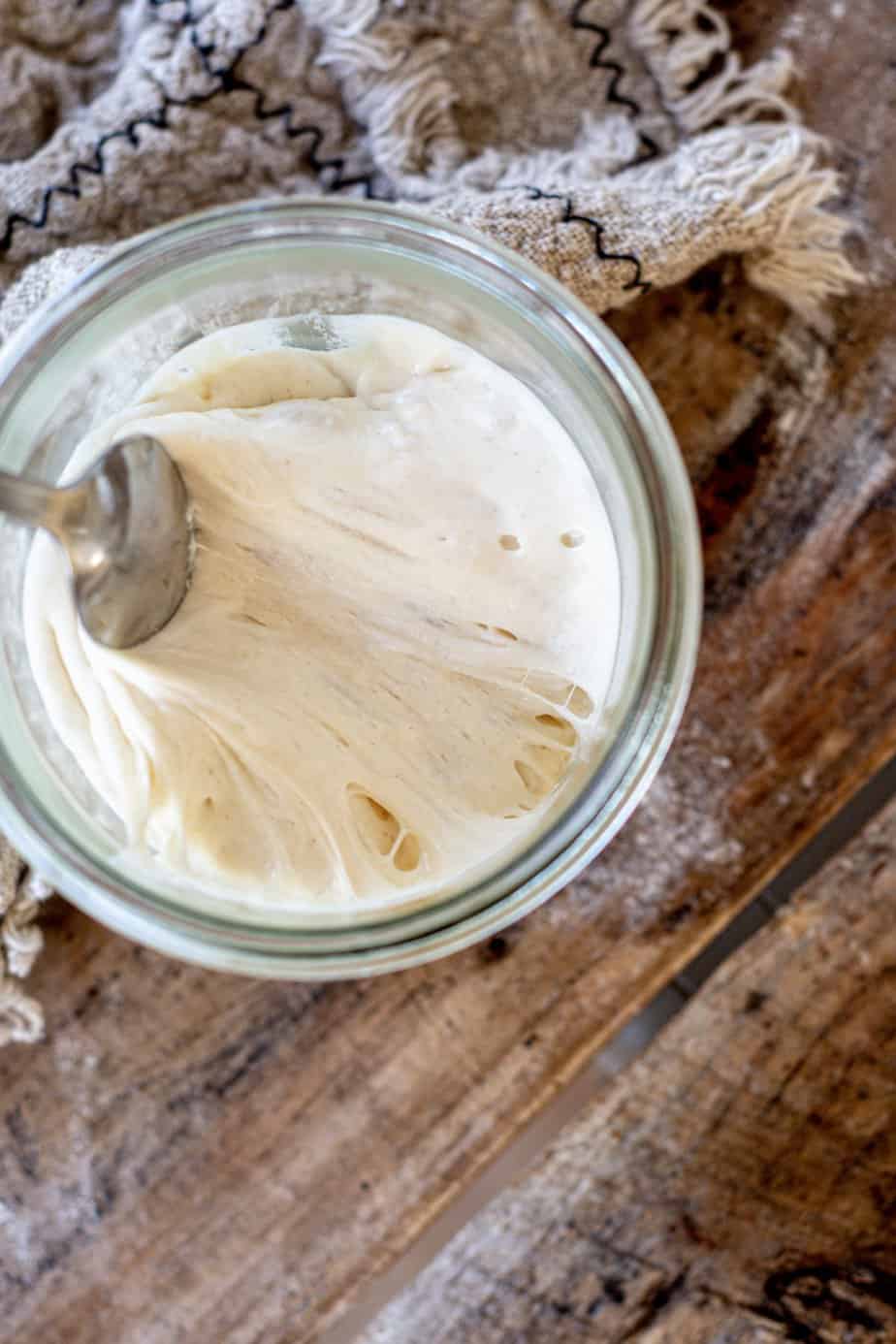
Rising times for ratios (in an ambient temperature spot)
1:1:1 – Starter should double within 4 hours
1:2:2 – Starter should double with 6 hours
1:3:3 – Starter should double with 8 hours
1:4:4 – The starter should double within 10 hours
and so forth…
The exact time it takes to double greatly depends on the room temperature. If your room temperature is cold, say at 15°C/60°F for example, it can take a long time for it to rise, even at a lower ratio.
Wrapping a rubber band around the jar of your starter to show where it comes up to when freshly mixed is a good visual guide to later see if the starter has doubled.
How to maintain a sourdough starter
A sourdough starter can be maintained either at room temperature or in the refrigerator. There are pros and cons to both methods. Maintaining a starter at room temperature means your starter will be active and ready to bake faster than if stored in the fridge.
However, it’s quite a commitment to keep it at room temperature because it will need very regular feedings – at least every 12 hours. Storing a starter in the fridge on the other hand means you can wait for much longer between feedings.
Room temperature sourdough starter maintenance
Room temperate is the best temperature for a sourdough starter in the sense that the yeast will multiply best in a warmer environment. This is particularly for a new starter. Room temperature is between 21°C and 26°C/ 70°F and 80°F.
However, because the fermentation process happens quickly in these temperatures, it must be fed regularly to stop the yeasts and bacteria from running out of food.
If you keep up with regular discarding and feeding at room temperature, the lactobacillus colony in the starter will thrive and you’ll have a healthy starter. As they thrive, the amount of lactic acid they produce will inhibit mold growth and harmful bacteria.
If you miss feedings while storing the starter at room temperature, the chance of mold and bad bacteria growing in the starter is very likely.
When storing a starter at room temperature you will need to feed it daily. How many times daily depends on the feeding ratio you are using.
At a ratio of 1:1:1, you will need to feed it at least twice daily, if not more. The best way to maintain your starter at room temperature is to feed it twice a day at 1:2:2 (once every 12 hours), or three times a day at 1:1:1.
These frequent feedings may need to be increased even more if the environment is very warm. You will need to gauge your own environment and see how the starter rises.
Sourdough starter maintenance fridge
Once your starter is well established, it can be refrigerated when it isn’t being used. Feed it beforehand and let it sit at room temperature for an hour or two, then place it in a sealed jar in the fridge.
A feeding of 1:1:1 can be used if you plan to use your starter again in the next day or two. Use the ratio of 1:2:2 if you don’t plan to bake for a week.
When you’re ready to bake with the starter that has been in the fridge, you can give it an extra feed before creating your starter for the bread. This will ensure the starter is in peak condition after being in the cold fridge.
If you’re planning to start making a sourdough bread recipe, remove the cold starter from the fridge the evening before and feed it 1:2:2 and leave it at room temperature overnight. The next day you can feed it and use it as you need to for the recipe.
How much sourdough starter to keep
The amount of sourdough starter to keep after using it for making bread changes depending on what method you use or how much starter you want. There are many different ways to do it. Here is one way –
From your jar of established starter, you’ll measure out two amounts. One is for your bread dough, and the second amount will create a new clean jar of starter to store for the next time.
Step 1 – Take your jar of starter. In a bowl measure and feed what you need for your bread recipe. Add this to a clean jar and set it aside ready for bread making.
Step 2 – With the remaining starter in the jar, in a separate bowl, measure out around 30g – 50g and feed this 1:1:1 or 1:2:2. Tip this mixture into a clean jar and store it in the fridge or on the bench. Discard any leftover starter from the old jar.
How much of the remaining starter you feed doesn’t matter. The mentioned 30g-50g is just a guide. If there is only 10g remaining, just feed that 1:2:2 or 1:3:3. Don’t be scared that you won’t have enough starter.
Even the smallest amount of starter can be built back up into a larger starter amount.
The excess starter that you are going to discard can be accumulated in a separate container and used for sourdough discard recipes.
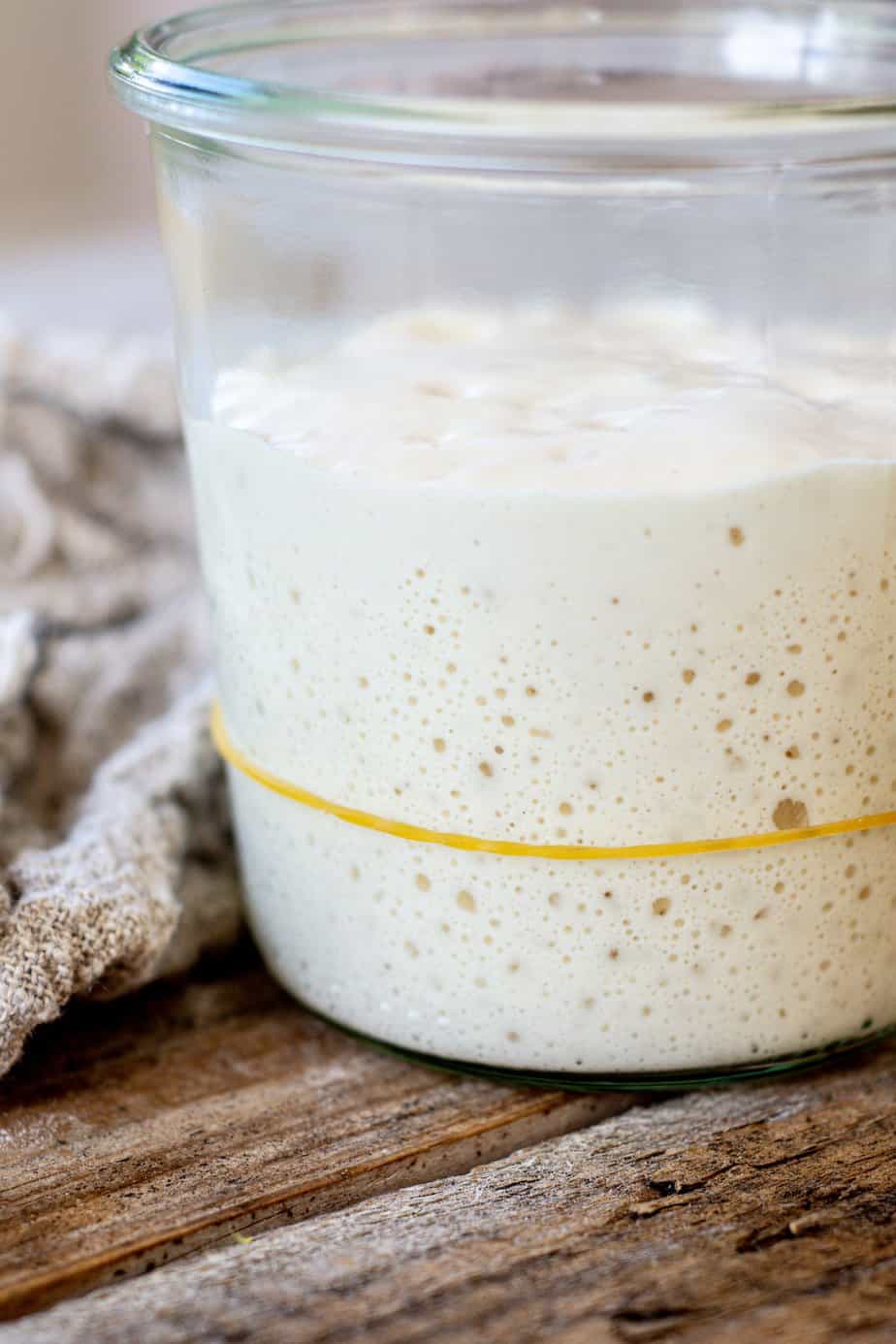
Mature starter vs young starter
The more time left between the feeding of your starter, the more mature your starter is. A mature sourdough starter has more acid build-up than a younger starter. A starter that has been fed and used within 6 hours will have less acid than if it was fed and used 12 hours later.
In the same regard, a starter fed 1:1:1 has a higher amount of seed starter than one fed at 1:2:2 and will therefore have more acid.
Using a ‘young’ starter with a low acid content allows your dough to be a lot more extensible and easy to work with. Acid breaks down the gluten bonds formed in flour, so a very acidic starter can make dough sloppy and tricky to manage. Regular feedings and keeping the seed starter amount low will help to ensure a lower acid content.
How to cover a sourdough starter
Cover your starter with a loosely balanced lid, compostable plastic wrap, or use a cloth. This will help to stop it from drying out and allow gases to escape.
Sometimes the top of your starter can dry out. Pull off the dried top and use what’s underneath. This can happen in a really warm environment. You can avoid this by placing it in a humid spot to rise, or using a lid that can trap moisture, like compostable plastic wrap or beeswax wrap. A yogurt maker makes a great humid rising spot for a starter. Fill the yogurt maker with warm water and let the starter rise in there.
When refrigerating a starter you can use a sealed lid. The rise and accumulation of gas will be much slower when it’s cold.
Recipes for sourdough baking
From a loaf of bread to brioche, to sourdough waffles! There is so much potential with a sourdough culture.
- Sourdough cinnamon rolls
- Pancakes with sourdough discard
- Sourdough gourmet crackers
- Ciabatta with sourdough starter




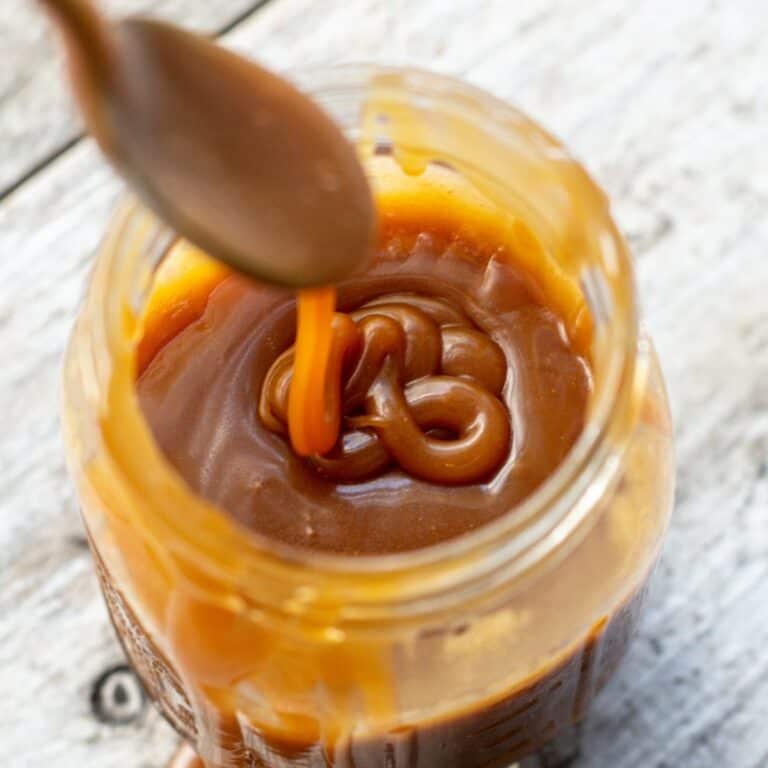

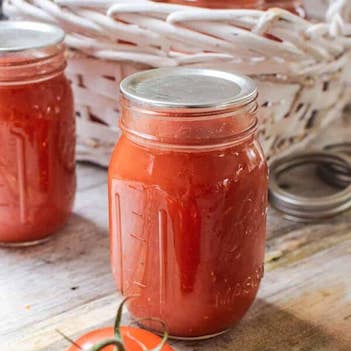
Wow. I learned tons. Thank you
So when storing the fridge you do weekly feedings at least?
Yup 🙂
Hi Elien, I would like to try your starter recipe. I have never made a sourdough starter before. so I am a little bit confused with your ratio of 1:1:1 and 1:2:2. Could you explain it for me? Thank you Anthony.
Hey Anthony, it’s best if you read this post first on starting a starter 🙂 that explains it all https://homegrownhappiness.com/starting-and-maintaining-a-sourdough-starter/